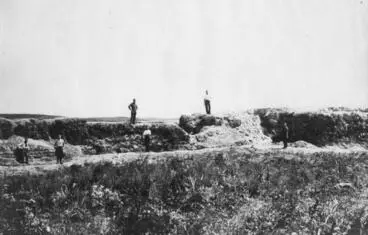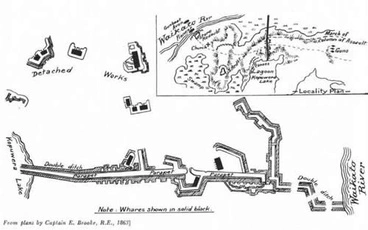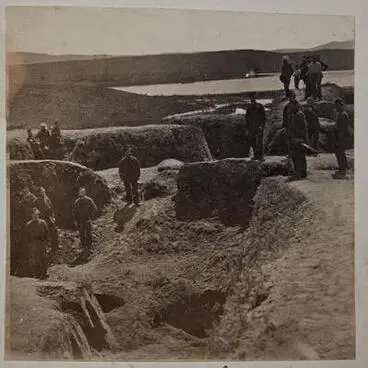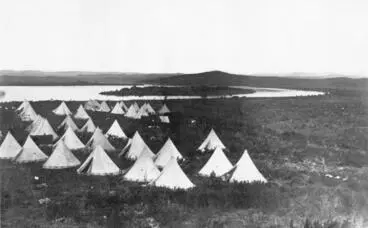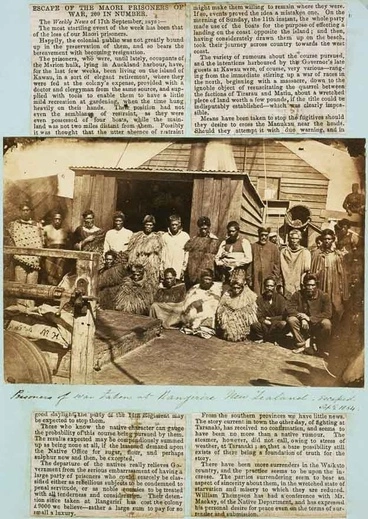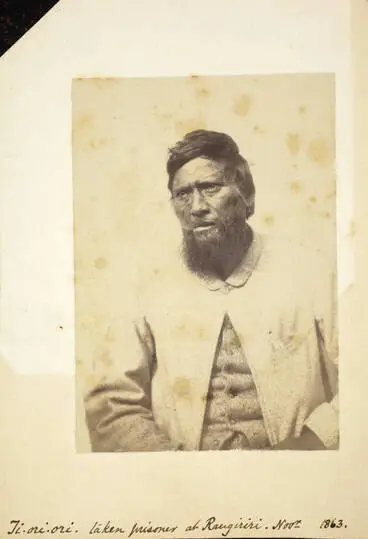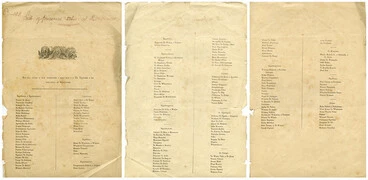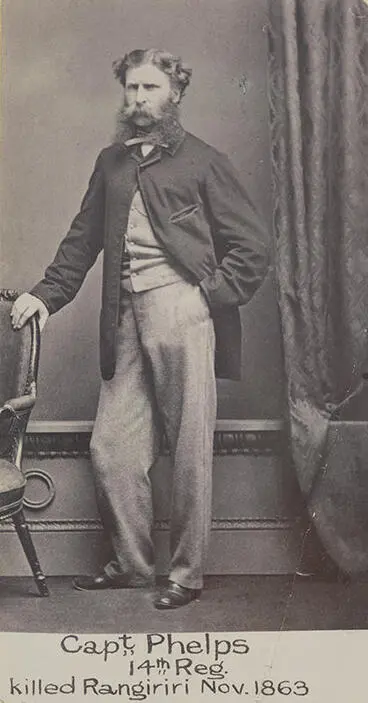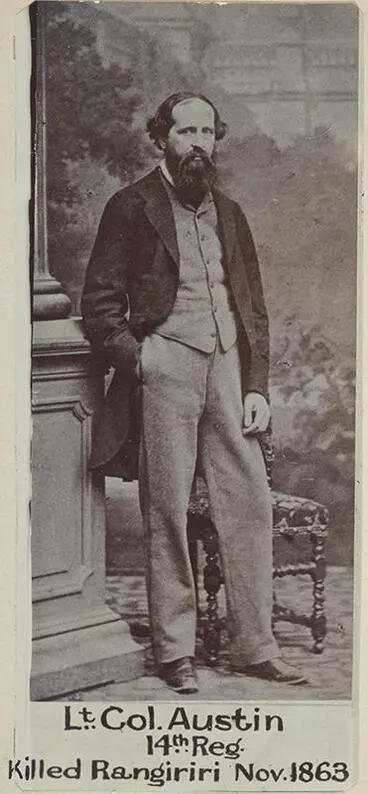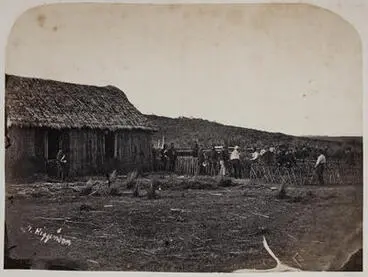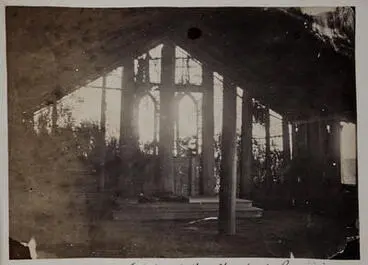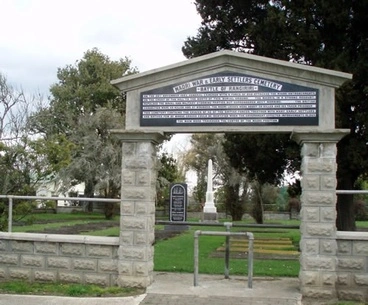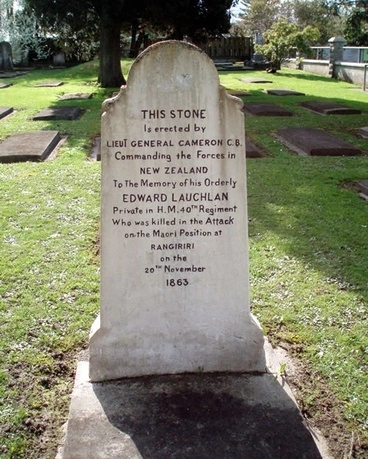Rangiriri - November 1863
A DigitalNZ Story by Janice
A set of images and articles on the battle at Rangiriri between Māori and Lieutenant-General Duncan Cameron, commander of the Imperial forces in November 1863.
New Zealand Wars, Colonial wars, Land wars, New Zealand Land wars, War in Waikato, Rangiriri
Kingitanga pā at Rangiriri
The decisive battle for Waikato was fought in November 1863 at Rangiriri, where a Māori defensive line was constructed along a ridge between the river and Lake Waikare.
Source: 'Rangiriri', URL: https://nzhistory.govt.nz/war/war-in-waikato/rangiriri, (Ministry for Culture and Heritage), updated 9-Apr-2019
Rangiriri Redoubt
MTG Hawke's Bay
Rangiriri pā - entrenchments and earthworks
The defences consisted of an entrenched parapet with ditches on both sides. Concealed rifle pits covered by fern were protected by wooden stakes driven into the ground.
Source: 'Rangiriri', URL: https://nzhistory.govt.nz/war/war-in-waikato/rangiriri, (Ministry for Culture and Heritage), updated 9-Apr-2019
Rangiriri - War in Waikato
Manatū Taonga, the Ministry for Culture and Heritage
Earthworks at Rangiriri, Waikato 1863
Museum of New Zealand Te Papa Tongarewa
Māori entrenchments at Rangiriri
Manatū Taonga, the Ministry for Culture and Heritage
Native earthworks at Rangiriri basically destroyed. Taken Nov 21 1863
Auckland War Memorial Museum Tāmaki Paenga Hira
Entrenchments at Rangiriri, Waikato
Alexander Turnbull Library
Cameron's army
On 20 November 1863 the British army assembled a land force of 850 men with three field guns supported by cannon aboard the Pioneer and Avon. Following a two-hour bombardment, Lieutenant General Duncan Cameron launched a frontal assault upon the pā.
Source: Danny Keenan, 'New Zealand wars - Waikato war: major battles', Te Ara - the Encyclopedia of New Zealand, http://www.TeAra.govt.nz/en/new-zealand-wars/page-6 (accessed 1 November 2019)
Rangiriri Encampment
MTG Hawke's Bay
Redmayne, Thomas, fl 1880s-1890s :Attack on the Maori Pah at Rangiriri. [1863]
Alexander Turnbull Library
Attack on Rangiriri
On the morning of 20 November they assembled a force of 860 men - backed up by artillery - just north of Rangiriri. Another 600 men were ferried upstream by the river fleet. Men from the 65th, 12th and 14th regiments were organised into three lines, with a detachment of the 40th and the remainder of the 65th in reserve. A scaling party carrying ladders and planks was poised for action.
Source: 'Rangiriri', URL: https://nzhistory.govt.nz/war/war-in-waikato/rangiriri, (Ministry for Culture and Heritage), updated 9-Apr-2019
Attack on Rangiriri
Manatū Taonga, the Ministry for Culture and Heritage
A bloody war
The exact number of Māori casualties is unknown. Forty-seven Māori, including four women and one child, are known to have been killed in action or died later from their wounds. Among them were Te Tutere of Ngāti Hauā, and Amukete Ta Kerei, a close relative of the Māori King, Tāwhiao. It is thought that 30 or 40 Māori were wounded.
Source: 'Rangiriri NZ Wars cemetery arch', URL: https://nzhistory.govt.nz/media/photo/rangiriri-nz-wars-cemetery-arch, (Ministry for Culture and Heritage), updated 3-Apr-2019
Hamley, Joseph Osbertus 1820-1911 :H.M.S. 'Esk' and the prison hulk 'Marion'
Alexander Turnbull Library
Prisoners of war taken at Rangiriri
Manatū Taonga, the Ministry for Culture and Heritage
Tioriori
Auckland Libraries
THE PRISONERS OF WAR. (Wellington Independent, 05 December 1863)
National Library of New Zealand
Printed list of Māori Prisoners taken at Rangiriri (1863)
Archives New Zealand Te Rua Mahara o te Kāwanatanga
The British suffered 130 casualties at Rangiriri. Of these, six officers and 41 men were killed in action or died later from their wounds. The officers – Captain Henry Mercer of the Royal Artillery; Midshipman Thomas Watkins of the Royal Navy; Lieutenant-Colonel Charles Austen, Lieutenant William Murphy and Captain John Phelps, of the 14th Regiment; and Ensign A. Ducrow of the 40th Regiment – were buried in Auckland’s Grafton Cemetery.
Source: 'Rangiriri NZ Wars cemetery arch', URL: https://nzhistory.govt.nz/media/photo/rangiriri-nz-wars-cemetery-arch, (Ministry for Culture and Heritage), updated 3-Apr-2019
Captain Mercer, about 1860
Museum of New Zealand Te Papa Tongarewa
Māori church and cemetery at Rangiriri
The Māori church at Rangiriri, photographed in 1864 by Daniel Manders Beere. The cemetery is in the foreground.
Source: 'Rangiriri NZ Wars cemetery in 1864', URL: https://nzhistory.govt.nz/media/photo/rangiriri-nz-wars-cemetery-1864-0, (Ministry for Culture and Heritage), updated 7-Jan-2014
Maori Church, Rangiriri, 1864
Alexander Turnbull Library
The mission church at Rangiriri and graveyard showing the graves of those who fell in the assault on it Nov. 20/63
Auckland War Memorial Museum Tāmaki Paenga Hira
Interior of the Church at Rangiriri New Zealand partly destroyed by shells during action
Auckland War Memorial Museum Tāmaki Paenga Hira
Newspaper reports from 1863
STORMING OF RANGIRIRI. (Wellington Independent, 01 December 1863)
National Library of New Zealand
Messenger with white flag
RANGIRIRI. (Taranaki Herald, 05 December 1863)
National Library of New Zealand
Lieut-General Cameron's letter to Governor Grey on the Battle of Rangiriri.
BATTLE OF RANGIRIRI. (Taranaki Herald, 26 December 1863)
National Library of New Zealand
FURTHER PARTICULARS FROM RANGIRIRI. (Wellington Independent, 10 December 1863)
National Library of New Zealand
Memorials
Rangiriri NZ Wars cemetery arch
Manatū Taonga, the Ministry for Culture and Heritage
Rangiriri grave
Manatū Taonga, the Ministry for Culture and Heritage
Commemoration and rememberance
Rangiriri Paa: cultural site an example of collaboration
Radio New Zealand
Rangiriri Pa returned after 1863 invasion
Radio New Zealand
